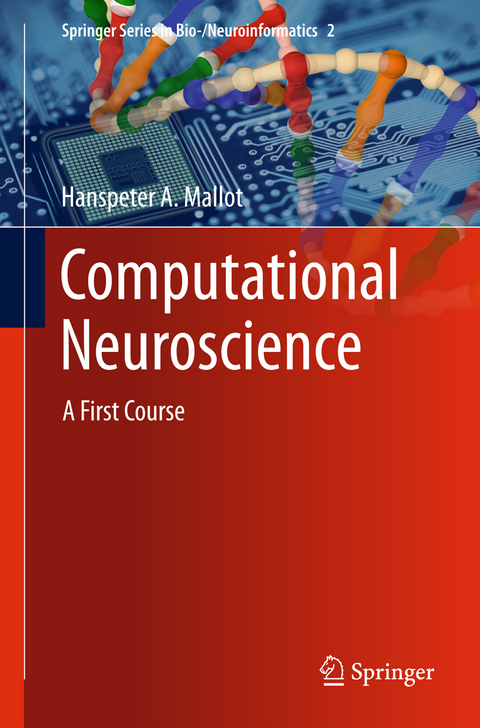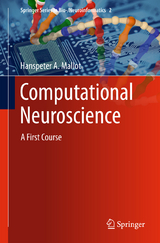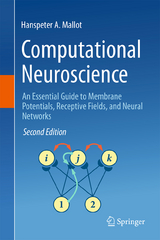Computational Neuroscience
Springer International Publishing (Verlag)
978-3-319-00860-8 (ISBN)
- Titel erscheint in neuer
- Artikel merken
Computational Neuroscience - A First Course provides an essential introduction to computational neuroscience and equips readers with a fundamental understanding of modeling the nervous system at the membrane, cellular, and network level. The book, which grew out of a lecture series held regularly for more than ten years to graduate students in neuroscience with backgrounds in biology, psychology and medicine, takes its readers on a journey through three fundamental domains of computational neuroscience: membrane biophysics, systems theory and artificial neural networks. The required mathematical concepts are kept as intuitive and simple as possible throughout the book, making it fully accessible to readers who are less familiar with mathematics. Overall, Computational Neuroscience - A First Course represents an essential reference guide for all neuroscientists who use computational methods in their daily work, as well as for any theoretical scientist approaching the field of computational neuroscience.
Dr. Hanspeter A. Mallot ist wissenschaftlicher Mitarbeiter am Max-Planck-Institut für biologische Kybernetik und Privatdozent für das Fach "Biologische Informationsverarbeitung" an der Eberhard-Karls-Universität Tübingen.
1 Excitable Membranes and Neural Conduction . . . . . . . . . . . . . . . . . . . . . 1.- 2 Receptive Fields and the Specificity of Neuronal Firing . . . . . . . . . . . . . 23.- 3 3 5 Coding and Representation . . . . . . . . . . . . . . . . . . . . . . . . . . . . . . . . . . . . . 115
. Fourier Analysis for Neuroscientists . . . . . . . . . . . . . . . . . . . . . . . . . . . . . . 57.- 4 Artificial Neural Networks . . . . . . . . . . . . . . . . . . . . . . . . . . . . . . . . . . . . . . 83.-
. . . . . . . . . . . . . . . . . . . . . . . . . . . . . . . . . . . . . 115
. Fourier Analysis for Neuroscientists . . . . . . . . . . . . . . . . . . . . . . . . . . . . . . 57.- 4 Artificial Neural Networks . . . . . . . . . . . . . . . . . . . . . . . . . . . . . . . . . . . . . . 83.-
. Fourier Analysis for Neuroscientists . . . . . . . . . . . . . . . . . . . . . . . . . . . . . . 57.- <4 Artificial Neural Networks . . . . . . . . . . . . . . . . . . . . . . . . . . . . . . . . . . . . . . 83.-
. . . . . . . . . . . . . . . . . . . . . . . . . . . . . . . . . . . . . . 83.- . . . . . . . . . . . . . 23.- 3 3 5 Coding and Representation . . . . . . . . . . . . . . . . . . . . . . . . . . . . . . . . . . . . . 115
. Fourier Analysis for Neuroscientists . . . . . . . . . . . . . . . . . . . . . . . . . . . . . . 57.- 4 Artificial Neural Networks . . . . . . . . . . . . . . . . . . . . . . . . . . . . . . . . . . . . . . 83.-
. . . . . . . . . . . . . . . . . . . . . . . . . . . . . . . . . . . . . 115
. Fourier Analysis for Neuroscientists . . . . . . . . . . . . . . . . . . . . . . . . . . . . . . 57.- 4 Artificial Neural Networks . . . . . . . . . . . . . . . . . . . . . . . . . . . . . . . . . . . . . . 83.-
. Fourier Analysis for Neuroscientists . . . . . . . . . . . . . . . . . . . . . . . . . . . . . . 57.- 4 Artificial Neural Networks . . . . . . . . . . . . . . . . . . . . . . . . . . . . . . . . . . . . . . 83.-
. . . . . . . . . . . . . . . . . . . . . . . . . . . . . . . . . . . . . . 83.- . . . . . . . . . . . . . . . . . . . . . 1.- 2 Receptive Fields and the Specificity of Neuronal Firing . . . . . . . . . . . . . 23.- 3 3 5 Coding and Representation . . . . . . . . . . . . . . . . . . . . . . . . . . . . . . . . . . . . . 115
. Fourier Analysis for Neuroscientists . . . . . . . . . . . . . . . . . . . . . . . . . . . . . . 57.- 4 Artificial Neural Networks . . . . . . . . . . . . . . . . . . . . . . . . . . . . . . . . . . . . . . 83.-
. . . . . . . . . . . . . . . . . . . . . . . . . . . . . . . . . . . . . 115
. Fourier Analysis for Neuroscientists . . . . . . . . . . . . . . . . . . . . . . . . . . . . . . 57.- 4 Artificial Neural Networks . . . . . . . . . . . . . . . . . . . . . . . . . . . . . . . . . . . . . . 83.-
. Fourier Analysis for Neuroscientists . . . . . . . . . . . . . . . . . . . . . . . . . . . . . . 57.- 4 Artificial Neural Networks . . . . . . . . . . . . . . . . . . . . . . . . . . . . . . . . . . . . . . 83.-
. . . . . . . . . . . . . . . . . . . . . . . . . . . . . . . . . . . . . . 83.- . . . . . . . . . . . . . 23.- 3 3 5 Coding and Representation . . . . . . . . . . . . . . . . . . . . . . . . . . . . . . . . . . . . . 115
. Fourier Analysis for Neuroscientists . . . . . . . . . . . . . . . . . . . . . . . . . . . . . . 57.- 4 Artificial Neural Networks . . . . . . . . . . . . . . . . . . . . . . . . . . . . . . . . . . . . . . 83.-
. . . . . . . . . . . . . . . . . . . . . . . . . . . . . . . . . . . . . 115
. . . . . . . . . . . . . . . . . . . . . 1.- 2 Receptive Fields and the Specificity of Neuronal Firing . . . . . . . . . . . . . 23.- 3 3 5 Coding and Representation . . . . . . . . . . . . . . . . . . . . . . . . . . . . . . . . . . . . . 115
. Fourier Analysis for Neuroscientists . . . . . . . . . . . . . . . . . . . . . . . . . . . . . . 57.- 4 Artificial Neural Networks . . . . . . . . . . . . . . . . . . . . . . . . . . . . . . . . . . . . . . 83.-
. . .
"A useful guide for any neuroscientist desiring to incorporate computational methods into their research. The book covers three fundamental areas of computational neuroscience: membrane physics, systems theory, and artificial neural networks. ... At the end each chapter, suggested reading materials are listed to help guide the reader to supporting resources which will fill in background material andor extend the topic presented." (Stanley R. Huddy, Mathematical Reviews, May, 2015)
"This book focuses on basic mathematical modeling approaches and computational methods in neuroscience, and it is a significant presentation of some basic aspects of computational neuroscience. ... I recommend it for students and researchers in neuroscience who are interested in mathematical modeling and computational methods." (Jin Liang, zbMATH 1317.92001, 2015)
"This is a good text discussing the mathematic neuromodeling introducing differential calculus inc. differential and partial differentional equations as they apply to temporal- spatial dynamics of the neural code. I recommend this book for all audiences with an interest in neuroscience." (Joseph J. Grenier, Amazon.com, August, 2014)
| Erscheint lt. Verlag | 5.6.2013 |
|---|---|
| Reihe/Serie | Springer Series in Bio-/Neuroinformatics |
| Zusatzinfo | XI, 135 p. |
| Verlagsort | Cham |
| Sprache | englisch |
| Maße | 155 x 235 mm |
| Gewicht | 364 g |
| Themenwelt | Informatik ► Theorie / Studium ► Künstliche Intelligenz / Robotik |
| Naturwissenschaften ► Biologie ► Humanbiologie | |
| Naturwissenschaften ► Biologie ► Zoologie | |
| Technik | |
| Schlagworte | Artificial Neural Networks • associative memory • Complexity • Fourier Analysis for Neuroscientists • Membrane potentials • Neural Cods and Popuulation Codes • Nonlinearities in receptive fields • Receptive Fields • Retinotopic mapping • Self-organization and competitive learning |
| ISBN-10 | 3-319-00860-9 / 3319008609 |
| ISBN-13 | 978-3-319-00860-8 / 9783319008608 |
| Zustand | Neuware |
| Informationen gemäß Produktsicherheitsverordnung (GPSR) | |
| Haben Sie eine Frage zum Produkt? |
aus dem Bereich





